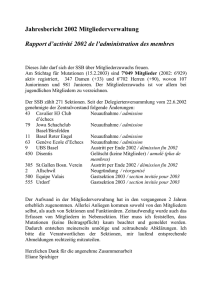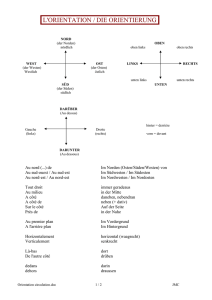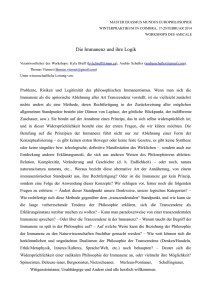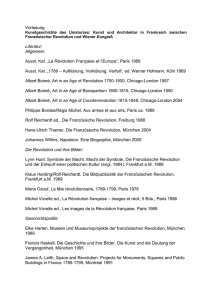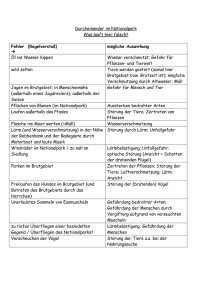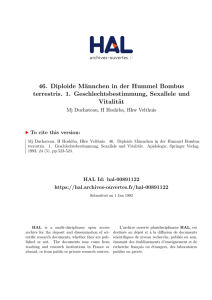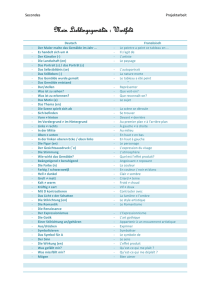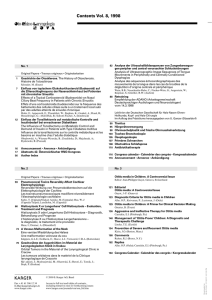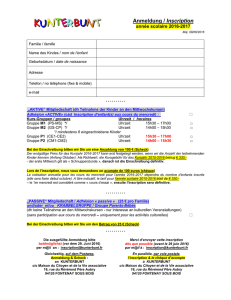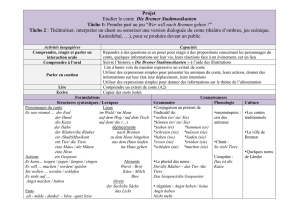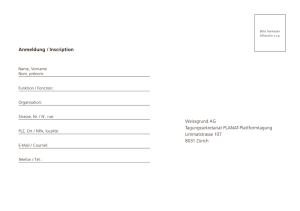Sonderausgabe 3 zum ABl. EPA 2011/41
Werbung
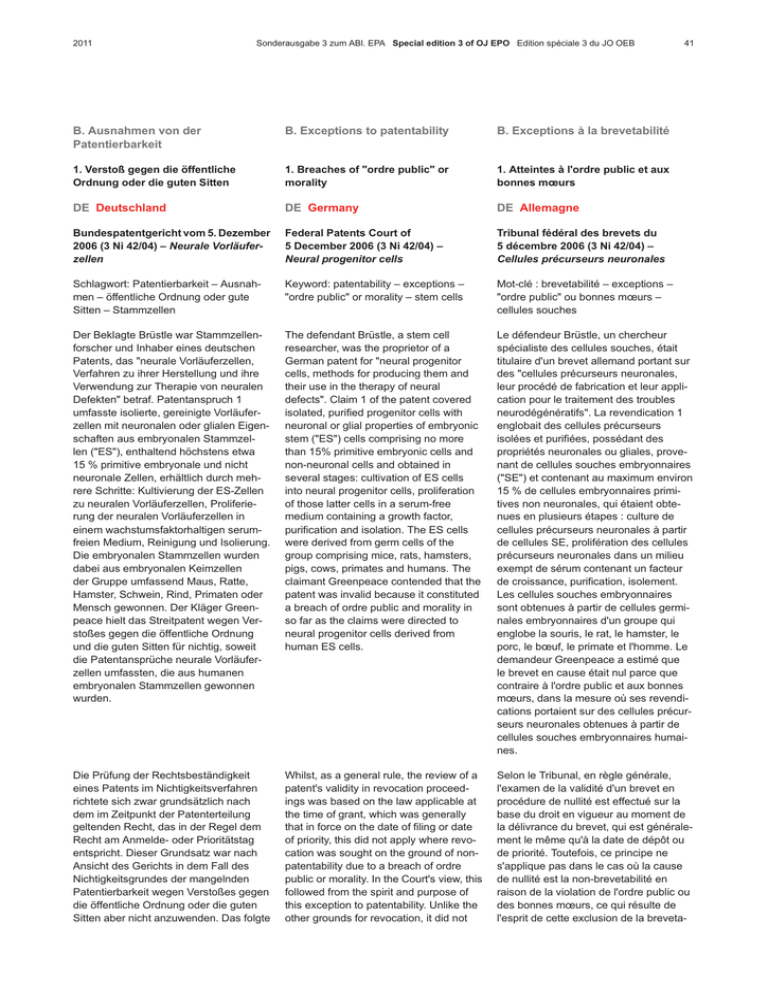
2011 Sonderausgabe 3 zum ABl. EPA Special edition 3 of OJ EPO Edition spéciale 3 du JO OEB 41 B. Ausnahmen von der Patentierbarkeit B. Exceptions to patentability B. Exceptions à la brevetabilité 1. Verstoß gegen die öffentliche Ordnung oder die guten Sitten 1. Breaches of "ordre public" or morality 1. Atteintes à l'ordre public et aux bonnes mœurs DE Deutschland DE Germany DE Allemagne Bundespatentgericht vom 5. Dezember 2006 (3 Ni 42/04) – Neurale Vorläuferzellen Federal Patents Court of 5 December 2006 (3 Ni 42/04) – Neural progenitor cells Tribunal fédéral des brevets du 5 décembre 2006 (3 Ni 42/04) – Cellules précurseurs neuronales Schlagwort: Patentierbarkeit – Ausnahmen – öffentliche Ordnung oder gute Sitten – Stammzellen Keyword: patentability – exceptions – "ordre public" or morality – stem cells Mot-clé : brevetabilité – exceptions – "ordre public" ou bonnes mœurs – cellules souches Der Beklagte Brüstle war Stammzellenforscher und Inhaber eines deutschen Patents, das "neurale Vorläuferzellen, Verfahren zu ihrer Herstellung und ihre Verwendung zur Therapie von neuralen Defekten" betraf. Patentanspruch 1 umfasste isolierte, gereinigte Vorläuferzellen mit neuronalen oder glialen Eigenschaften aus embryonalen Stammzellen ("ES"), enthaltend höchstens etwa 15 % primitive embryonale und nicht neuronale Zellen, erhältlich durch mehrere Schritte: Kultivierung der ES-Zellen zu neuralen Vorläuferzellen, Proliferierung der neuralen Vorläuferzellen in einem wachstumsfaktorhaltigen serumfreien Medium, Reinigung und Isolierung. Die embryonalen Stammzellen wurden dabei aus embryonalen Keimzellen der Gruppe umfassend Maus, Ratte, Hamster, Schwein, Rind, Primaten oder Mensch gewonnen. Der Kläger Greenpeace hielt das Streitpatent wegen Verstoßes gegen die öffentliche Ordnung und die guten Sitten für nichtig, soweit die Patentansprüche neurale Vorläuferzellen umfassten, die aus humanen embryonalen Stammzellen gewonnen wurden. The defendant Brüstle, a stem cell researcher, was the proprietor of a German patent for "neural progenitor cells, methods for producing them and their use in the therapy of neural defects". Claim 1 of the patent covered isolated, purified progenitor cells with neuronal or glial properties of embryonic stem ("ES") cells comprising no more than 15% primitive embryonic cells and non-neuronal cells and obtained in several stages: cultivation of ES cells into neural progenitor cells, proliferation of those latter cells in a serum-free medium containing a growth factor, purification and isolation. The ES cells were derived from germ cells of the group comprising mice, rats, hamsters, pigs, cows, primates and humans. The claimant Greenpeace contended that the patent was invalid because it constituted a breach of ordre public and morality in so far as the claims were directed to neural progenitor cells derived from human ES cells. Le défendeur Brüstle, un chercheur spécialiste des cellules souches, était titulaire d'un brevet allemand portant sur des "cellules précurseurs neuronales, leur procédé de fabrication et leur application pour le traitement des troubles neurodégénératifs". La revendication 1 englobait des cellules précurseurs isolées et purifiées, possédant des propriétés neuronales ou gliales, provenant de cellules souches embryonnaires ("SE") et contenant au maximum environ 15 % de cellules embryonnaires primitives non neuronales, qui étaient obtenues en plusieurs étapes : culture de cellules précurseurs neuronales à partir de cellules SE, prolifération des cellules précurseurs neuronales dans un milieu exempt de sérum contenant un facteur de croissance, purification, isolement. Les cellules souches embryonnaires sont obtenues à partir de cellules germinales embryonnaires d'un groupe qui englobe la souris, le rat, le hamster, le porc, le bœuf, le primate et l'homme. Le demandeur Greenpeace a estimé que le brevet en cause était nul parce que contraire à l'ordre public et aux bonnes mœurs, dans la mesure où ses revendications portaient sur des cellules précurseurs neuronales obtenues à partir de cellules souches embryonnaires humaines. Die Prüfung der Rechtsbeständigkeit eines Patents im Nichtigkeitsverfahren richtete sich zwar grundsätzlich nach dem im Zeitpunkt der Patenterteilung geltenden Recht, das in der Regel dem Recht am Anmelde- oder Prioritätstag entspricht. Dieser Grundsatz war nach Ansicht des Gerichts in dem Fall des Nichtigkeitsgrundes der mangelnden Patentierbarkeit wegen Verstoßes gegen die öffentliche Ordnung oder die guten Sitten aber nicht anzuwenden. Das folgte Whilst, as a general rule, the review of a patent's validity in revocation proceedings was based on the law applicable at the time of grant, which was generally that in force on the date of filing or date of priority, this did not apply where revocation was sought on the ground of nonpatentability due to a breach of ordre public or morality. In the Court's view, this followed from the spirit and purpose of this exception to patentability. Unlike the other grounds for revocation, it did not Selon le Tribunal, en règle générale, l'examen de la validité d'un brevet en procédure de nullité est effectué sur la base du droit en vigueur au moment de la délivrance du brevet, qui est généralement le même qu'à la date de dépôt ou de priorité. Toutefois, ce principe ne s'applique pas dans le cas où la cause de nullité est la non-brevetabilité en raison de la violation de l'ordre public ou des bonnes mœurs, ce qui résulte de l'esprit de cette exclusion de la breveta- 42 Sonderausgabe 3 zum ABl. EPA Special edition 3 of OJ EPO Edition spéciale 3 du JO OEB 2011 aus dem Sinn und Zweck dieses Patentierungsausschlusses. Er bezog sich im Gegensatz zu den anderen Nichtigkeitsgründen nicht auf die Erfindung selbst und ihre nach der Rechtslage am Anmelde- oder Prioritätstag vorzunehmende technische Prüfung, sondern knüpfte an die Verwertung der Erfindung nach der Patenterteilung an. relate to the invention itself or its technical examination under the law applicable at the filing or priority date, but rather to its use after grant. bilité. Contrairement aux autres causes de nullité, celle-ci ne se rapporte pas à l'invention elle-même et à l'examen technique à effectuer sur la base de la situation juridique à la date de dépôt ou de priorité, mais à l'exploitation de l'invention après la délivrance du brevet. Nach Ansicht des Gerichts wurden mit dem Streitpatent ausdrücklich menschliche Embryonen als Edukte für die Gewinnung embryonaler Stammzellen beansprucht. Es handelte sich also nicht um eine lediglich hypothetisch mögliche Form der Benutzung der Erfindung, die nicht zu Lasten des Beklagten unterstellt werden dürfte, sondern um einen von ihm selbst konkret genannten bestimmungsgemäßen Gebrauch. Es widerspräche dem Sinn und Zweck des Patentierungsverbots nach § 2 PatG, die erklärte Benutzungsabsicht des Patentinhabers außer Betracht zu lassen und die Patentierbarkeit im Hinblick auf die zulässige Form der Benutzung der Erfindung mit tierischen embryonalen Stammzellen oder menschlichen embryonalen Keimzellen in vollem Umfang unter Einschluss des gegen die öffentliche Ordnung oder die guten Sitten verstoßenden Teils der Erfindung anzuerkennen. In the Court's view, the patent in question expressly claimed human embryos as starting material for ES cells. Therefore, this was not merely a hypothetically possible use of the invention, which could not be imputed to a defendant to his detriment, but rather an intended use specifically mentioned by the defendant himself. It would run counter to the spirit and purpose of the exception to patentability under § 2 German Patents Act to disregard the patent proprietor's stated intention as to use and, in view of the permissible use with animal ES cells or human embryonic cells, deem the invention patentable in its entirety, including that part not in keeping with ordre public and morality. Selon le Tribunal, le brevet en cause revendiquait explicitement les embryons humains comme source à partir de laquelle pouvaient être obtenues des cellules souches embryonnaires. Il ne s'agissait donc pas seulement d'une forme hypothétique d'exploitation de l'invention, qu'il ne faudrait pas sousentendre au détriment du défendeur, mais d'un mode d'exploitation adéquat qu'il a lui-même indiqué. Il serait contraire à l'esprit des dispositions du § 2 Loi allemande sur les brevets concernant l'exclusion de la brevetabilité de mettre de côté l'exploitation prévue explicitement par le titulaire et de reconnaître la brevetabilité en totalité, eu égard aux formes admissibles d'exploitation à partir de cellules souches embryonnaires animales ou de cellules germinales embryonnaires humaines, y compris la brevetabilité de la partie de l'invention qui est contraire à l'ordre public ou aux bonnes mœurs. Gemäß § 8 (1) ESchG gilt als Embryo im Sinne dieses Gesetzes u. a. jede einem Embryo entnommene totipotente Zelle, die sich bei Vorliegen der dafür erforderlichen weiteren Voraussetzungen zu teilen und zu einem Individuum zu entwickeln vermag. Das Gericht stellte fest, bei pluripotenten Stammzellen handele es sich nach den Angaben in der Streitpatentschrift um Vorläuferzellen, welche in viele verschiedene, reife Zelltypen ausdifferenzieren können. Es bestehen bereits erhebliche Bedenken, ob die Ansprüche überhaupt das Erfordernis der ursprünglichen Offenbarung erfüllen und ob der Fachmann am Anmeldetag die im Streitpatent ausschließlich genannten totipotenten Stammzellen auch als pluripotente Stammzellen gelesen habe. Die in Rede stehenden Stammzellen werden im Streitpatent nämlich nicht nur durchgehend ausschließlich als totipotent beschrieben, sondern es werde streitpatentgemäß im Zusammenhang mit den den verwendeten Begriffen zugrunde liegenden Definitionen überdies expressis verbis § 8(1) German Act on the Protection of Embryos defined embryo for the purposes of that legislation as, inter alia, any totipotent cell derived from an embryo which was capable of dividing and developing into an individual if the additional conditions were met. The Court stated that, according to the information in the patent specification, pluripotent stem cells were progenitor cells which could differentiate into a wide variety of mature cell types. It was already doubtful whether the claims even met the requirement of original disclosure and whether, at the date of filing, the skilled person would have understood the exclusive reference in the patent to totipotent stem cells to include pluripotent stem cells. Not only were the stem cells in question described exclusively as totipotent throughout the patent, but the wording used in the patent to set out the underlying definitions also distinguished expressly between pluripotent and totipotent. A way of producing human ES cells on the basis of which the skilled En vertu du § 8(1) Loi allemande sur la protection des embryons, le mot embryon au sens de cette loi désigne, entre autres, toute cellule totipotente extraite d'un embryon, qui, en présence des autres conditions requises, est capable de se diviser et d'engendrer un nouvel individu. Quant aux cellules souches pluripotentes, le Tribunal a indiqué qu'il s'agissait, d'après les indications contenues dans le fascicule du brevet en cause, de cellules précurseurs qui ont la faculté de se différencier en de nombreux types de cellules adultes différentes. Il y avait déjà de bonnes raisons de douter que les revendications remplissent la condition de suffisance de l'exposé et que l'homme du métier ait pu, à la date de dépôt, comprendre que les cellules souches totipotentes, les seules mentionnées dans le brevet, étaient censées couvrir aussi les cellules souches pluripotentes. En effet, les cellules souches en question étaient non seulement systématiquement décrites dans le brevet comme étant exclusivement des cellules totipotentes, mais de 2011 Sonderausgabe 3 zum ABl. EPA Special edition 3 of OJ EPO Edition spéciale 3 du JO OEB 43 zwischen pluripotent und totipotent unterschieden. Ein Weg zur Herstellung von humanen embryonalen Stammzellen, anhand dessen der Fachmann am Anmeldetag hätte ersehen können, welche Stammzellen zur Verwendung gemäß Streitpatent vorgesehen gewesen sein könnten, werde nicht angegeben. person at the date of filing could have identified which stem cells might have been intended for use according to the patent was not indicated. plus il y était expressément fait une distinction, dans le contexte des définitions des termes employés, entre pluripotent et totipotent. De plus, il n'était indiqué aucune méthode d'obtention des cellules souches embryonnaires humaines, qui aurait permis à l'homme du métier de reconnaître à la date de dépôt quel type de cellules souches il était recommandé d'utiliser dans le brevet en cause. Diese Frage konnte nach Auffassung des Gerichts jedoch für die Entscheidung über die Nichtigkeitsklage dahingestellt bleiben, weil unabhängig davon, ob die Stammzellen totipotent oder pluripotent sind oder ob ES-Zelllinien verwendet werden, zu ihrer Gewinnung am Anmeldetag stets Embryonen verbraucht werden mussten. Der Beklagte hatte weder zur Überzeugung des Gerichts vorgetragen noch war ersichtlich, dass sich hieran bis zum Zeitpunkt der Entscheidung über die Nichtigkeitsklage Grundlegendes geändert hätte. Das Brüstle-Patent wurde somit für nichtig erklärt. However, the Federal Patents Court found that this question could remain unanswered for the purposes of ruling on the action for revocation because, irrespective of whether the stem cells were totipotent or pluripotent or whether ES cell lines were used, embryos always had to be used to derive them at the date of filing. The defendant had failed to persuade the Court, and it was not otherwise apparent, that there had been any fundamental change in this respect at the time of ruling. The Brüstle patent was therefore revoked. De l'avis du Tribunal, cette question pouvait toutefois être laissée de côté pour la décision sur l'action en nullité, étant donné que, indépendamment de la question de la totipotence ou pluripotence des cellules souches ou de l'utilisation de lignes de cellules SE, leur obtention nécessitait forcément, à la date de dépôt, de détruire des embryons. Le défendeur n'avait pas soumis d'arguments pour convaincre le Tribunal du contraire et il ne semblait pas qu'un changement majeur soit intervenu dans cet état de fait avant que soit rendue la décision sur la nullité. Le brevet Brüstle a donc été déclaré nul. Anmerkung des Herausgebers: Im Berufungsverfahren hat der Bundesgerichtshof am 17. Dezember 2009 beschlossen, den Gerichtshof der Europäischen Union insbesondere nach der Auslegung des Begriffs "menschlicher Embryo" zu fragen, der in der Richtlinie 98/44/EG über den rechtlichen Schutz biotechnologischer Erfindungen nicht definiert wird. Dabei ging es um die Frage, ob der Ausschluss des menschlichen Embryos von der Patentierbarkeit alle Stadien des Lebens von der Befruchtung der Eizelle an umfasst oder ob zusätzliche Voraussetzungen erfüllt sein müssen, z. B., dass ein bestimmtes Entwicklungsstadium erreicht ist. Editor's note: On appeal, the German Federal Court of Justice decided on 17 December 2009 to refer questions to the Court of Justice of the European Union concerning the interpretation of, in particular, the concept of "human embryo", which was not defined in Directive 98/44/EC on the legal protection of biotechnological inventions. The question was whether the exclusion from patentability of the human embryo covered all stages of life from fertilisation of the ovum or whether other conditions had to be met, for example that a certain stage of development be reached. Note de la rédaction : dans le cadre d'une procédure d'appel, la Cour fédérale de justice allemande a décidé, le 17 décembre 2009, de soumettre à la Cour de justice de l'Union européenne des questions sur l'interprétation de la notion d'"embryon humain" notamment, non définie par la directive 98/44/CE relative à la protection juridique des inventions biotechnologiques. Il s'agissait de savoir si l'exclusion de la brevetabilité de l'embryon humain concerne tous les stades de la vie à partir de la fécondation de l'ovule, ou si d'autres conditions doivent être remplies, par exemple le fait qu'un certain stade de développement soit atteint. Am 18. Oktober 2011 urteilte der Gerichtshof der Europäischen Union in der Rechtssache C-34/10 Oliver Brüstle v. Greenpeace e. V., dass der menschliche Embryo in allen Lebensstadien von der Befruchtung der Eizelle an von der Patentierbarkeit ausgeschlossen ist. Der Gerichtshof legte den Begriff "menschlicher Embryo" sehr breit aus und verwies auf das Ziel der Richtlinie 98/44/EG, das darin bestehe, jede Möglichkeit der Patentierung auszuschließen, sobald die der Menschenwürde geschuldete Achtung dadurch beeinträchtigt werden könnte. So umfasse der Begriff "mensch- On 18 October 2011, the Court of Justice of the European Union issued its decision in Oliver Brüstle v Greenpeace e.V. – Case C-34/10, thereby establishing the exclusion from patentability of the human embryo at all stages of life from fertilisation of the ovum. In interpreting the concept of "human embryo" very broadly, the Court referred to the aim of Directive 98/44/EC, which was, according to the Court, to exclude the possibility of patentability in all cases where respect for human dignity could be affected. Accordingly, the term "human embryo" comprised any human Le 18 octobre 2011, la Cour de justice de l'Union européenne a rendu son arrêt dans l'affaire Oliver Brüstle c. Greenpeace e.V. (affaire C-34/10). Selon cet arrêt, l'embryon humain est exclu de la brevetabilité à tous les stades de la vie à partir de la fécondation de l'ovule. La Cour a interprété de manière très large la notion d'"embryon humain", se référant à cet égard au but de la directive 98/44/CE, qui est, selon la Cour, d'exclure toute possibilité de brevetabilité dès lors que le respect dû à la dignité humaine pourrait en être affecté. Il en résulte que les termes d' "embryon 44 Sonderausgabe 3 zum ABl. EPA Special edition 3 of OJ EPO Edition spéciale 3 du JO OEB 2011 licher Embryo" jede menschliche Eizelle vom Stadium ihrer Befruchtung und Totipotenz an sowie jede nicht befruchtete menschliche Eizelle, die durch künstliche Mittel totipotent gemacht wurde. Zu Stammzellen, die von einem menschlichen Embryo im Stadium der Blastozyste gewonnen werden, stellte der Gerichtshof fest, dass es Sache des nationalen Gerichts ist, im Licht der technischen Entwicklung festzustellen, ob sie geeignet sind, den Prozess der Entwicklung eines Menschen in Gang zu setzen, und folglich unter den Begriff des "menschlichen Embryos" fallen. Darüber hinaus verwehrte der Gerichtshof die Erlangung von Patentschutz für die Zwecke der wissenschaftlichen Forschung. Auch wenn das Ziel der wissenschaftlichen Forschung von industriellen oder kommerziellen Zwecken zu unterscheiden sei, so wäre eine Verwendung menschlicher Embryonen zu Forschungszwecken, wenn sie Gegenstand einer Patentanmeldung sei, untrennbar mit diesem Patent verbunden. Eine Ausnahme ließ der Gerichtshof jedoch zu: Die Verwendung von menschlichen Embryonen sollte nicht von der Patentierbarkeit ausgeschlossen werden, wenn sie zu therapeutischen oder diagnostischen Zwecken erfolgt und auf den menschlichen Embryo zu dessen Nutzen anwendbar ist, z. B. um eine Missbildung zu beheben. ovum as soon as fertilised and totipotent, as well as a non-fertilized human ovum, which had been rendered totipotent by artificial means. As regards stem cells obtained from a human embryo at the blastocyst stage, the Court stated that it was for the referring court to ascertain, in the light of scientific developments, whether they were capable of commencing the process of development of a human being and therefore fell within the scope of the term "human embryo". Moreover, the Court refused patent protection for scientific research. Although the aim of scientific research should be distinguished from industrial or commercial purposes, when research using human embryos was the subject matter of a patent application, it was intrinsically linked with that patent. However, the Court made one exception: where therapeutic or diagnostic purposes useful to the human embryo were applied to it, for example to correct a malformation, the use of human embryos should not be excluded from patentability. humain" couvrent tout ovule humain, dès qu'il est fécondé et totipotent, ainsi que tout ovule humain non fécondé qui a été rendu totipotent par des moyens artificiels. S'agissant des cellules souches obtenues à partir d'un embryon humain au stade du blastocyste, la Cour a déclaré qu'il appartient à la juridiction nationale de déterminer, à la lumière des développements de la science, si elles sont de nature à déclencher le processus de développement d'un être humain et si, par conséquent, elles relèvent de la notion d' "embryon humain". De plus, la Cour a rejeté toute protection par brevet pour la recherche scientifique. Même si le but de la recherche scientifique doit être distingué des fins industrielles ou commerciales, les activités de recherche qui utilisent des embryons humains sont intrinsèquement liées à un brevet lorsqu'elles constituent l'objet de la demande à l'origine de ce brevet. La Cour a cependant énoncé une exception, à savoir que l'utilisation d'embryons humains ne devrait pas être exclue de la brevetabilité si elle est destinée à des fins thérapeutiques ou de diagnostic utiles à l'embryon humain et applicables à celui-ci, en vue par exemple de corriger une malformation. 2. Medizinische Methoden 2. Medical methods 2. Méthodes de traitement médical DE Deutschland DE Germany DE Allemagne Bundesgerichtshof vom 19. Dezember 2006 (X ZR 236/01) – Carvedilol II Federal Court of Justice of 19 December 2006 (X ZR 236/01) – Carvedilol II Cour fédérale de justice du 19 décembre 2006 (X ZR 236/01) – Carvedilol II Schlagwort: Patentierbarkeit – Ausnahmen – therapeutisches Verfahren – Verabreichung eines Stoffs Keyword: patentability – exceptions – method for treatment – administration of a substance Mot-clé : brevetabilité – exceptions – méthode de traitement – administration d'une substance Der vorliegende Fall betraf Patentansprüche, die neben Merkmalen des zu verabreichenden Wirkstoffs (Carvedilol) und der Indikation (kongestivem Herzversagen) auch Anweisungen zu der Art der Verabreichung enthielten (u. a. 7-28 Tage einmal täglich mit Dosissteigerungen bis zu einer Maximaldosis). Das BPatG hatte das Streitpatent antragsgemäß für nichtig erklärt. Hiergegen This case concerned patent claims containing, in addition to features of the drug to be administered (Carvedilol) and the indication (congestive heart failure), instructions on the manner of administration (incl. once daily for 7 to 28 days with increases in dosage up to a maximum). The Federal Patents Court had granted an application for revocation. On appeal to the Federal Court of Justice, the La présente affaire concernait des revendications qui, à côté des caractéristiques de la substance active à administrer (Carvedilol) et de l'indication médicale (défaillance cardiaque congestive), contenaient également des instructions sur le mode d'administration (une fois par jour pendant 7 à 28 jours, avec une augmentation de la posologie jusqu'à une dose maximale, entre autres). Le Tribunal
